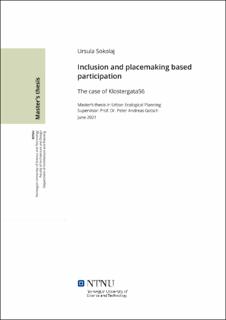| dc.description.abstract | A city's public spaces play an integral part in the daily lives of people and, when altered, the costs and benefits affect everyone. Hence, they should be the product of democratic tools and inclusive processes, all part of the umbrella of participatory planning. Public participation in decision-making processes is important as it reveals the different views and perspectives of the affected stakeholders, allowing them to have an impact on the outcome. The methodology and management of the process are crucial in achieving fruitful and truly representative outcomes. In the case of poor representation or conflicting visions, it is not easy to ensure that different voices are equally involved and weigh in the same in the decisions taken. This brings up issues of inclusion and exclusion, which go hand in hand with social inequality.
This thesis is a case study research, which focuses on the process of co-designing Klostergata56, a small, underutilized public space in the Norwegian city of Trondheim. Using placemaking as a participatory planning tool, the community and relevant stakeholders are given the opportunity to share their thoughts and design ideas, which will then be reflected in the final design intervention activating the space. While the importance of evaluating participatory processes is receiving increasing attention, little progress has been done in developing measurable assessment tools. The study therefore develops a framework to analyze the placemaking based participatory process, and applies it to the case of Klostergata56 to investigate its level of inclusion. Data is gathered by combining qualitative methods in the pursuit of triangulation – case study observations of the author, interviews with participants of the process, as well as interviews with experts from the field. The study concludes that the process had significant limitations to being inclusive, because some important stakeholders did not participate, there was a range in the level of participation reached by the engaged groups, and just a few of them were actively involved. Moreover, differences are potentially created in levels of nurtured social capital and civic trust. The high range of setbacks, caused by the facilitators, the stakeholders and even the context, as the study argues, makes it virtually impossible to have a fully inclusive process. However, even if inclusion is a goal that cannot be fully attained, it is still important to put forth explicit efforts to reach as close to it as possible. | |
